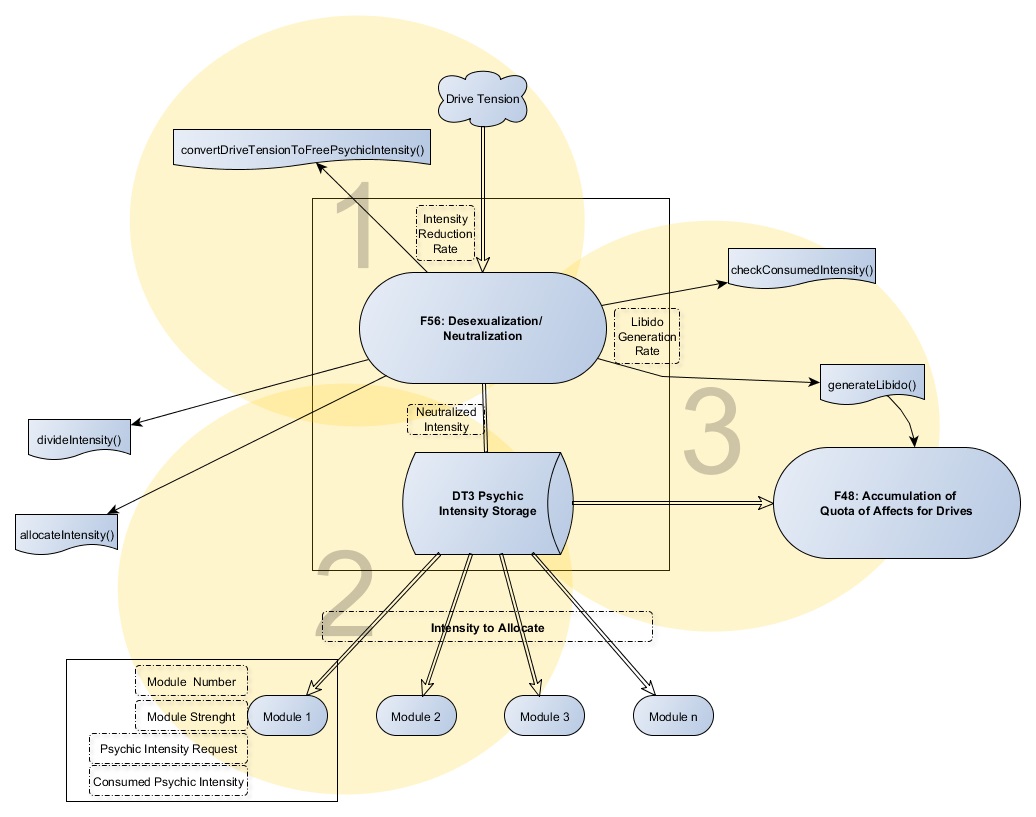F56 – Desexualization/Neutralization
Technische Modulbeschreibung
- Affektbeträge von Trieben verringern
- Aufteilung von Affektbeträgen auf die verschiedenen Module
- Kontrolle der Menge der abgeführten neutralisierten Triebintensität
- Generierung von Lust (entsprechend der abgeführten neutralisierten Triebintensität)
Inhaltliche Modulbeschreibung
The task of the module (F56) can be divided in 3 steps (see figure below):
1) To proportionally reduce from every DM (drive Mesh) in the input list some psychic intensity (according to a personality parameter) and divide the psychic intensity to allocate later to other modules.
2) To allocate the reduced psychic intensity to other modules through a buffer or temporary storage.
3) To read from the buffer the actual amount of psychic intensity used in the last iteration t=t-in order to generate pleasure according to the amount of actual used psychic intensity and to send this pleasure to the libido buffer (DT1_LibidoBuffer).
 Figure 1: Schematic Representation of F56
Figure 1: Schematic Representation of F56
As already said, there is a buffer or temporary storage object for the psychic intensity (DT3). In order for F56 to allocate the intensity among the dependent modules (for instance F7 and F23) without being in direct contact with them, the Buffer DT3_PsychicIntensityStorage is implemented. Among other information, this buffer has two important numeric values:
a) The actual amount of psychic intensity that is available at t=t,
b) The amount of used intensity in the last iteration t=t-1.
In order to access DT3, different interfaces are defined and used by the dependent modules.
Implementation of F56
In F56_Desexualization_Neutralization, a reference to the buffer (DT3_PsychicIntensityStorage) is allocated in order to facilitate the allocation of free psychic intensity. Additionally, in F56, two personality parameters (values from 0 to 1) are laid:
a) mrIntensityReductionRate: it determines de prosentual proportion of drive tension which will be at disposal as free psychic intensity.
b) mrLibidoGenerationRate: it regulates the generation of pleasure by used psychic intensity.
The tasks of F56 are distributed among four methods:
a) convertDriveTensionToFreePsychicIntensity(),
b) divideFreePsychicIntensity(),
c) checkConsumedIntensity()
d) generateLibido()
After initialization, at T >= 1, F56 reduces the psychic intensity from the respective modules. If the module is “undefined,” F56 uses mrIntensityReductionRateSexual in order to multiply it with the QuotaAffect of the module. On the other hand, if the module is “defined,” mrIntensityReductionRateSelfPreserv is used. These two rates are different but equal. There are more than 15 such a modules from which intensity will be reduced and transformed to neutralized intensity. These intensities are summed up and sent to DT3. Once F56 has sent the neutralized intensity to DT3, this last one can divide it. Later on, the modules demanding neutralized intensity can try to provide themselves.
DT3 allocates neutralized psychic intensity in T=t before modules demanding neutralized intensity give to know their requests. From the point of view of the implementation, this is a constraint because there is no way that DT3 can know the requests in T=t. DT3 could consider the requests made in T=t, if at the beginning of iteration T the modules give to know their request. If that is not the case, DT3 just can estimate it according to some internal rules and past experience.
In order to split the intensity before the modules can collect them, DT3 calculate an estimation of what might be in T=t the total demand of intensity. As well, DT3 calculates the sum of priorities given by the total addition of individual module strengths multiplied by the individual intensity demands. In the present, these values are as well estimations that do not take account of the module’s strengths and intensity demands at T=t but at T = t-1,t-2,t-3,t-4, and t-5.
Once the modules have collected their corresponding allocated psychic intensity and have used it, they give to know at T=t their actual psychic intensity request that will be considered for division at T=t+1 by F56. As well, they have to give to know to F56 how much psychic intensity was used at T=t. At T=t+1, F56 will use this last information in order to generate lust.
Input
I5.3 von F54 – Emersion of blocked drive content
Output
I5.4 zu F55 – Super-Ego proactive